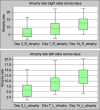The Utility of Muscle Ultrasound as a Predictor of Outcome in Guillain-Barré Syndrome Patients in the Intensive Care Unit: A Prospective Cohort Study
- PMID: 40110240
- PMCID: PMC11915401
- DOI: 10.5005/jp-journals-10071-24928
The Utility of Muscle Ultrasound as a Predictor of Outcome in Guillain-Barré Syndrome Patients in the Intensive Care Unit: A Prospective Cohort Study
Abstract
Aims and background: Guillain-Barré syndrome (GBS) is associated with significant muscle loss, which can result in prolonged intensive care. The aim of this study was to evaluate muscle atrophy in GBS patients using serial ultrasound measurements of rectus femoris cross-sectional area (RFCSA).
Materials and methods: A prospective study was carried out among GBS patients admitted to the intensive care unit (ICU). All clinical and demographic variables were recorded at admission.Ultrasound measurement of RFCSA was done at baseline and 3, 7, and 14 days after ICU admission. Clinical outcomes such as the ICU stay and duration of mechanical ventilation were studied at discharge.
Results: A total of 25 patients were studied. The mean age was 48.96 ± 14.82 years, 44% were female, and 25% experienced significant muscle atrophy in the first 72 hours. The percentage changes in the RFCSA were 5.21 (3.38-8.39), 9.18 (5.52-11.76), and 12.63 (8.65-15.09) on days 3, 7, and 14, respectively. A greater muscle atrophy rate was strongly positively correlated with longer ventilation periods [atrophy day 14 (r = 0.88, p < 0.001)] and atrophy day 7 (r = 0.87, p < 0.001) and total number of ICU days [atrophy day 14 (r = 0.93, p < 0.001)].
Conclusion: Muscle ultrasound (MUSG) shows potential as a tool for monitoring muscle atrophy in GBS patients. However, its ability to reliably identify patients at risk for prolonged ICU stays and mechanical ventilation requires cautious interpretation and further validation due to the absence of a comparator.
Clinical significance: The findings of this study highlight the utility of bedside MUSG as a non-invasive tool for monitoring muscle atrophy in neuromuscular diseases and critically ill patients.Early identification of significant muscle loss allows for timely interventions, risk stratification, and resource optimization, ultimately improving ICU outcomes and patient recovery trajectories.
How to cite this article: Naik SS, Desai M, Krishnakumar M, Nashi S, Varadarajan B. The Utility of Muscle Ultrasound as a Predictor of Outcome in Guillain-Barré Syndrome Patients in the Intensive Care Unit: A Prospective Cohort Study. Indian J Crit Care Med 2025;29(3):262-267.
Keywords: Critical Care; Guillain–Barré syndrome; Muscle ultrasound; Sarcopenia.
Copyright © 2025; The Author(s).
Conflict of interest statement
Source of support: Nil Conflict of interest: NoneConflict of interest: None
Figures






References
LinkOut - more resources
Full Text Sources
